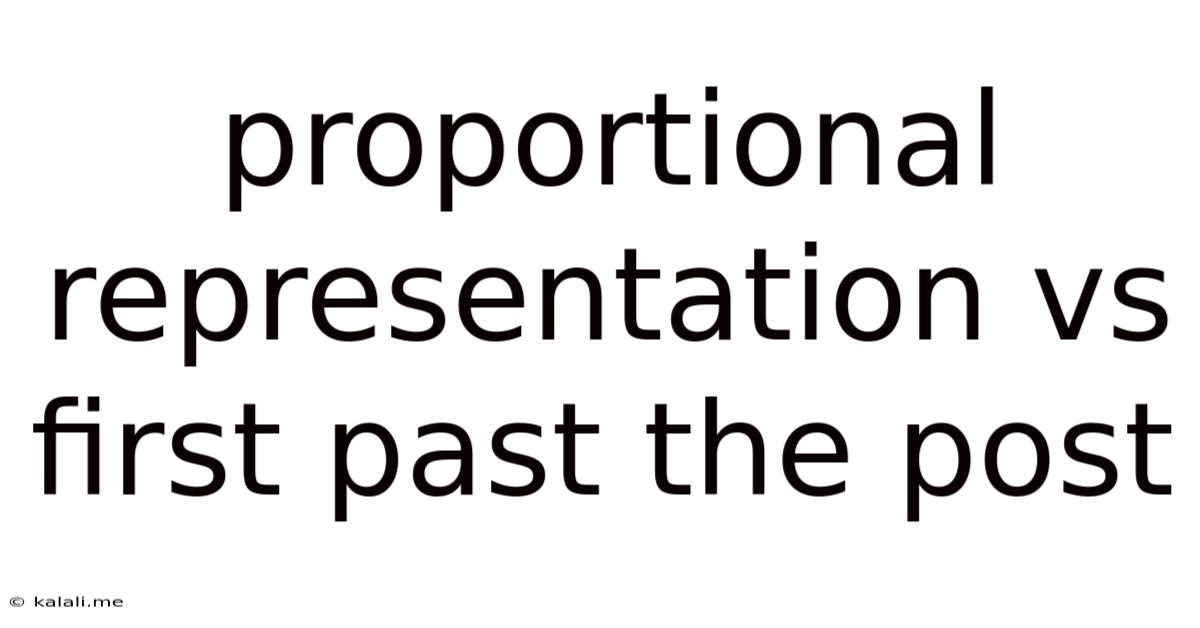Proportional Representation Vs First Past The Post
Kalali
Jun 11, 2025 · 3 min read

Table of Contents
Proportional Representation vs. First Past the Post: A Head-to-Head Comparison
Choosing the right voting system is crucial for a healthy democracy. Two dominant systems stand out: Proportional Representation (PR) and First Past the Post (FPTP), also known as "winner-takes-all." This article will delve into the strengths and weaknesses of each, exploring their impact on political representation and stability. Understanding these differences is key to evaluating a nation's electoral landscape and its potential for effective governance.
What is First Past the Post (FPTP)?
FPTP is a simple system where the candidate with the most votes in each constituency wins the seat. It's straightforward to understand and count, leading to quick results. However, this simplicity masks significant drawbacks. A party can win a majority of seats with less than 50% of the national vote, leading to disproportionate representation and potentially undermining the will of the electorate. This can result in "wasted votes," where votes cast for losing candidates or parties have no impact on the final outcome.
Advantages of FPTP:
- Simplicity and ease of understanding: The system is easily grasped by voters.
- Strong constituency links: Elected representatives are directly accountable to their local constituents.
- Clear winner and strong government: Typically leads to a single-party government with a clear mandate.
Disadvantages of FPTP:
- Disproportionate representation: Smaller parties are often underrepresented or completely excluded.
- Wasted votes: Votes cast for losing candidates are effectively ignored.
- Encourages two-party dominance: Often creates a two-party system, limiting voter choice and political diversity.
- Can lead to minority governments with unstable coalitions: In some cases, no party achieves a majority, leading to fragile coalitions.
What is Proportional Representation (PR)?
Proportional representation aims to allocate seats in proportion to the votes received. Various types of PR exist, including party-list systems (where voters choose a party and seats are allocated based on national vote share) and mixed-member proportional systems (combining elements of FPTP and PR). The goal is to create a more accurate reflection of the electorate's preferences in the legislature.
Advantages of PR:
- Fairer representation: Smaller parties and minority viewpoints have a greater chance of representation.
- Reduced wasted votes: Votes contribute to the overall party representation.
- Increased political diversity: Encourages coalition governments and broader political participation.
- Enhanced voter engagement: Knowing their vote is more likely to influence the outcome encourages higher voter turnout.
Disadvantages of PR:
- Complexity: Counting votes and allocating seats can be more complex than FPTP.
- Potential for coalition governments: Coalition building can be lengthy and lead to political instability.
- Weaker constituency links: Representatives may be less accountable to specific local areas.
- Rise of extremist parties: Some argue that PR can give undue influence to smaller, extremist parties.
FPTP vs. PR: A Summary Table
| Feature | First Past the Post (FPTP) | Proportional Representation (PR) |
|---|---|---|
| Simplicity | High | Low |
| Representation | Disproportionate | Proportional |
| Wasted Votes | High | Low |
| Government Type | Usually single-party, potentially unstable coalitions | Often coalition governments |
| Constituency Links | Strong | Weaker |
| Voter Turnout | Potentially lower | Potentially higher |
Conclusion: Choosing the Right System
Both FPTP and PR have their merits and demerits. The "best" system depends on a nation's specific political landscape, culture, and priorities. FPTP offers simplicity and strong constituency links, but at the cost of disproportionate representation. PR provides fairer representation and encourages political diversity, but it can lead to complex coalition governments. The choice ultimately involves weighing the trade-offs between these competing values. Understanding these differences empowers citizens to engage in informed discussions about electoral reform and the future of their democracy.
Latest Posts
Latest Posts
-
How Many Dimes Are In 5 Dollars
Jul 01, 2025
-
How Many Cups Is 12 Oz Of Chocolate Chips
Jul 01, 2025
-
How Do You Beat Level 7 On Bloxorz
Jul 01, 2025
-
What Grade Level Do You Learn Algebra 1
Jul 01, 2025
-
How Long Ago Was The 16th Century
Jul 01, 2025
Related Post
Thank you for visiting our website which covers about Proportional Representation Vs First Past The Post . We hope the information provided has been useful to you. Feel free to contact us if you have any questions or need further assistance. See you next time and don't miss to bookmark.